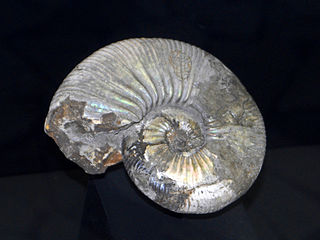
Acanthohoplites is an extinct genus of ammonites in the family Parahoplitidae that lived in the Aptian and Early Albian stages of the Early Cretaceous.
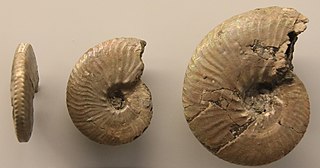
Anahoplites is a genus of rather involute, compressed hoplitid ammonites with flat sides, narrow flat or grooved venters, and flexious ribs or striae arising from weak umbilicle tubercles that end in fine dense ventrolateral nodes. The elements of their sutures are short, wide and jaggedy. Specimens of Annahoplites have diameters typically in the range of 4–6 centimetres (1.6–2.4 in) although some with diameters of as much as 19 centimetres (7.5 in) have been reported. The genus lived during the Cretaceous, from the Middle to the late Albian.

Aulacostephanus is an extinct ammonoid cephalopod genus from the Upper Jurassic Tithonian belonging to the perisphinctacean family Aulacostephanidae.
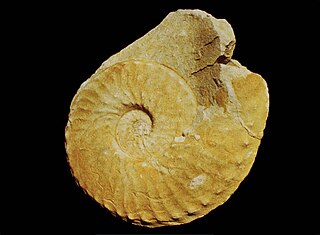
Schloenbachia is a genus of ammonoid cephalopods from the Cenomanian stage of the Upper Cretaceous, and type for the Schloenbachiidae, a family within the ammonitid Hoplitoidea.

Placenticeras is a genus of ammonites from the Late Cretaceous. Its fossils have been found in Asia, Europe, North and South America.
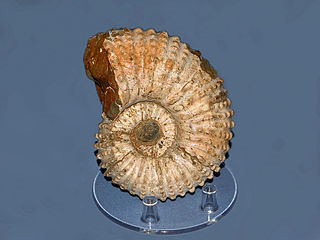
Douvilleiceras is a genus of ammonites from the Middle to Late Cretaceous. Its fossils have been found worldwide, in Africa, Asia, Europe, and North and South America.

Hoplites is a genus of ammonite that lived from the Early Albian to the beginning of the Middle Albian. Its fossils have been found in Europe, Transcaspia and Mexico. Shell has compressed, rectangular till depressed and trapezoidal whorl section. There are strong umbilical bullae from which, prominent ribs are branching and these are interrupted on venter. Ends of ribs on the venter are prominent and can be both alternate or opposite. Some species have zigzagging ribs and these ribs ends usually thickened, or they can be raised into ventrolateral tubercles. These tubercles are mostly oblique clavi.

Pachydiscus is an extinct genus of ammonite from the Late Cretaceous with a worldwide distribution, and type for the desmoceratacean family Pachydiscidae. The genus' type species is P. neubergicus. Altogether some 28 species have been described.

The Hoplitidae is a family of Cretaceous ammonites that lived during the middle of the period from the late Aptian to the Cenomanian. They are part of the superfamily Hoplitoidea.
Callihoplites is a genus of rather evolute ammonites from the Lower Cretaceous, Late Albian. Its whorl section squarish or compressed, inner whorls bearing umbilical bullae and ventrolateral clavi, with or without looped ribs between. The body chamber is smooth with a rounded venter.
Leymeriellidae is a family of Lower Cretaceous ammonites comprising rather small forms distinguished from Hoplitidae by their flattened and grooved ribs and virtual absence of umbilical tubercles. The family is derived from the Desmoceratidae. Leymeriella schrammeni anterior has evolved from Desmoceras keilhacki keilhacki.

Holcodiscidae is an ammonite family placed in the Ammonite superfamily Desmoceratoidea.
Proplacenticeras is a discoidal ammonite from the lower part of the Upper Cretaceous and precursor of the overall similar Placenticeras.
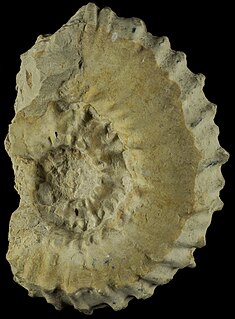
Watinoceras is a genus of acanthoceratid ammonite that lived during the early Turonian stage of the Late Cretaceous.
Cunningtoniceras is a stocky acanthoceratid ammonite from the upper Cenomanian stage of the late Cretaceous of the western U.S., found e.g. in Arizona and New Mexico.
Neocardioceras is a genus of evolute acanthoceratid ammonites from the uppermost Cenomanian, Upper Cretaceous, of Europe, western U.S. and Brazil.
Flickiidae is a family of dwarf ammonites with little ornament and very simples sutures known from small pyritic specimens found in middle Cretaceous deposits. Inclusion in the Acanthoceratoidea is tentative.

Cleviceras is an extinct genus of cephalopod belonging to the family Hildoceratidae. These cephalopods existed in the Jurassic period, during Toarcian and possibly even uppermost Pliensbachian age. Sometimes, it is considered to be a synonym of Eleganticeras.
Otohoplites is a genus of ammonite that lived in the Early Albian age and whose fossils were found in Svalbard, Denmark, England, France, Austria, Poland, Russia and Kazakhstan. It has evolved from Hemisonneratia and gave rise to the genus Hoplites. Shells belonging to this genera are rather inflated to compressed and have zigzagging, or looped ribs that end in oblique ventrolateral clavi. Usually, ribs are zigzagging through venter. Macroconchs have a smooth body chamber and rounded venter.
Antarcticoceras is a genus of crioconic ammonites in the family Shasticrioceratidae. It lived during the Early Cretaceous Period. Antarcticioceras fossils can be found in the Cretaceous rocks of Antarctica and South America.













